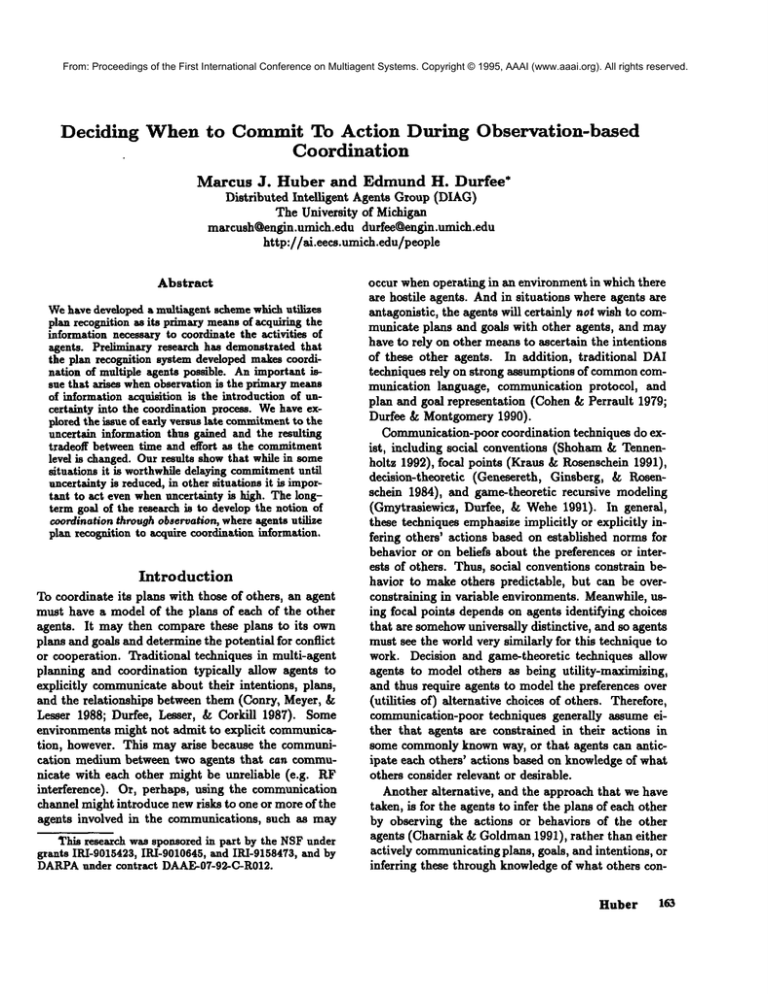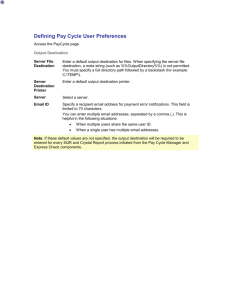
From: Proceedings of the First International Conference on Multiagent Systems. Copyright © 1995, AAAI (www.aaai.org). All rights reserved.
Deciding
When to Commit To Action During Observation-based
Coordination
Marcus J. Huber and Edmund H. Durfee*
Distributed Intelligent Agents Group(DIAG)
The University of Michigan
marcushQengin.umich.edu duffee~engin.umich.edu
http://ai.eecs.umich.edu/people
occur whenoperating in an environmentin whichthere
are hostile agents. Andin situations whereagents are
Wehavedevelopeda multiagentschemewhichutilizes
antagonistic, the agents will certainly not wishto complan recognitionas its primarymeansof acquiringthe
municate plans and goals with other agents, and may
informationnecessaryto coordinatethe activities of
haveto rely on other meansto ascertain the intentions
agents. Pr~llmlnaryresearch has demonstratedthat
of these other agents. In addition, traditional DAI
the plan recognition systemdevelopedmakescoorditechniques rely on strong assumptionsof common
comnation of multipleagents possible. Animportantissue that arises whenobservationis the primarymeans
munication language, communication protocol, and
of informationacquisition is the introductionof unplan and goal representation (Cohen& Perrault 1979;
certainty into the coordinationprocess. WehaveexDurfee & Montgomery1990).
ploredthe issue of early versuslate commitment
to the
Communication-poor
coordination techniques do exuncertain informationthus gained and the resulting
tradeof betweentime and effort as the commitment
ist, including social conventions (Shoham& Tennenlevel is changed.Ourresults showthat while in some
holtz 1992), focal points (Kraus & Rosenschein1991),
situations it is worthwhiledelayingcommitment
until
decision-theoretic (Genesereth, Ginsberg, & Rosenuncertaintyis reduced,in other situations it is imporschein 1984), and game-theoretic recursive modeling
tant to act evenwhenuncertainty is high. Thelongtermgoal of the researchis to developthe notion of
(Gmytrasiewicz, Durfee, & Wehe1991). In general,
coordinationthroughobservation,whereagentsutilize
these techniquesemphasizeimplicitly or explicitly inplan recognitionto acquirecoordinationinformation.
feting others’ actions based on established normsfor
behavior or on beliefs about the preferences or interests of others. Thus, social conventionsconstrain beIntroduction
havior to makeothers predictable, but can be overTo coordinate its plans with those of others, an agent
constraining in variable environments.Meanwhile,usmust have a model of the plans of each of the other
ing focal points dependson agents identifying choices
agents. It maythen comparethese plans to its own
that are somehow
universally distinctive, and so agents
plans and goals and determinethe potential for conflict
must see the world very similarly for this techniqueto
or cooperation. Traditional techniques in multi-agent
work. Decision and game-theoretic techniques allow
planning and coordination typically allow agents to
agents to model others as being utility-maximizing,
explicitly communicateabout their intentions, plans,
and thus require agents to modelthe preferences over
and the relationships between them (Conry, Meyer,
(utilities of) alternative choices of others. Therefore,
communication-poortechniques generally assume eiLesser 1988; Durfee, Lesser, & Corkill 1987). Some
environmentsmightnotadmit to explicit
communica- ther that agents are constrained in their actions in
tion,however.
Thismayarisebecause
thecommuni- some commonlyknownway, or that agents can anticcationmediumbetween
twoagentsthatcancommuipate each others’ actions based on knowledgeof what
nicate
witheachothermightbe unreliable
(e.g.RF
others consider relevant or desirable.
interference).
Or,perhaps,
usingthecommunication Anotheralternative, and the approach that we have
channel
might
introduce
newrisks
tooneormoreofthe
taken, is for the agents to infer the plans of each other
agents
involved
in thecommunications,
suchas may
by observing the actions or behaviors of the other
Thisresearch
wassponsored
inpartbytheNSFunder agents (Charniak & Goldman1991), rather than either
actively communicating
plans, goals, and intentions, or
grants IRI-9015423,IRI-9010645,and IRI-9158473,and by
DARPA
under contract DAAE-07-92-C-R012.
inferring these through knowledgeof what others conAbstract
Huber 163
From: Proceedings of the First International Conference on Multiagent Systems. Copyright © 1995, AAAI (www.aaai.org). All rights reserved.
sider relevant or desirable. Moreover, the same coordination techniques may be applied to the recognized
plans that were employed when explicit communication about plans was the means used for acquiring coordination information. Agents coordinating through
the use of plan recognition do not even need to have
a common communications medium or language. In
fact, nothing has to be in commonamong the agents
other than the knowledgeof the observed agent’s possible goals, and the actions it will exhibit while pursuing
those goals. Perception capable of making observations of other agents’ behavior is also necessary, but is
not dependent upon the other agents in the world. The
various agents, then, maybe heterogeneous, having different representations of models and plans, perceptual
¯ capabilities, communicationmeans, etc.
Werecognize, however, that there are costs associated with the plan recognition process. These costs include the introduction of uncertainty due to imperfect
observation and inferencing (Huber & Durfee 1993),
additional computation time and effort to perform plan
and goal inferencing, and the relative difficulty (compared to direct communication methods) of recognizing and incorporating new goals and behaviors into
the models of other agents (Huber, Durfee, & Wellman 1994). Cooperating agents will need to weigh the
costs and risks associated with explicit communication
against the costs associated with plan recognition. If
explicit communication is relatively inexpensive and
risk free it is probably advantageous for the agent to
utilize it. On the other hand, as explained above,
there will be circumstances that may force an agent
to use observation and plan recognition to cooperate
with other agents. We think that by experimenting
with plan recognition in a variety of domains, we will
gain a deeper understanding of the situations in which
plan recognition is, and is not, a useful process.
In this paper, we present preliminary research results
showing that multiple agents employing plan recognition can successfully coordinate their activities.
We
have further explored one of the significant issues identified during the preliminary research, that of the uncertainty introduced by inferencing during the plan
recognition process, and we present the results of this
research.
We are working towards a more formal
examination of coordination through observation, the
paradigm in which multiple agents can coordinate their
behavior through the use of plan recognition for plan
and goal recognition.
our plan recognition system and the integration of the
plan recognition system into agents performing navigation tasks in the environment.
The environment in which our agents act is a discrete
time, two-dimensional, simulated grid world. This
environment was created using MICE (Montgomery
& Durfee 1990), a testbed designed explicitly for ex~
perimentation with multiple agcnt coordination techniques. The agents in this environment were limited
to the primitive actions of motion (movement north,
south, east, or west) or no motion. Two types of
agents were implemented: observed agents ("bounding
agents" or "bounders") and observing agents ("overwatching agents" or "overwatchers"). The bounding
agents were given a goal to occupy a certain designated location, and would head directly for that location throughout an experiment. The overwatching
agents observed the actions of the bounding agents,
tried to infer the goals of the observed agents (the particular goal destination), and acted accordingly. The
behavior of the overwatching agents will be explained
in more detail later.
The bounding agent’s heuristics were quite simple.
Placed in some initial starting location, and given
a goal location, the agent would plan the shortest,
straight-line path to the goal and then start moving
toward it. Oncethe bounding agent arrived at its goal,
it would then remain motionless for the remainder of
the experiment.
The overwatching agent’s heuristics were variable.
In all cases the agent wouldreact to its beliefs by moving to a particular destination location. This destination could be the same location, a nearby location, or
a location opposite to that which the bounding agent
was moving towards, depending upon the heuristics
specified at the beginning of tile experiment. The first
heuristic, movingto the same location as thc observed
agent, might be used if the agents were supposed to
rendezvous, enabling them to do this without having
to explicitly communicate with each other. The second heuristic, movingto a nearby destination location,
might be used if the two agents were supposed to perform surveillance, where the "destinations" might be
hilltops and the coordination results in a larger coverage area. The third type of heuristic, moving to an
opposite location, might be used if the agents were adversaries and the overwatching agent wanted to avoid
being noticed by the other agent.
Goal Inference
Probabilistic
Plan Recognition
In this section, we first discuss our experimentation
environment and agent capabilities. Wethen describe
164
ICMAS-g$
The overwatching agent’s primary objective was to
accurately infer the goal (the final destination)
the bounding agent. To do this, each overwatching
From: Proceedings of the First International Conference on Multiagent Systems. Copyright © 1995, AAAI (www.aaai.org). All rights reserved.
agent employed a belief network implemented using the
IDEALsystem (Srinivas & Breese 1990). The IDEAL
system consists of a collection of LISP functions that
permit the construction and maintenance of belief networks, the accumulation of observations, and the subsequent propagation of the beliefs throughout the network in order to perform plan inferencing. At each
simulated time step, the overwatching agent would observe the actions of the bounding agent. This evidence
was added to the history of previously observed actions and the beliefs of the Bayesian network would
then be updated. With consistent and reinforcing evidence, belief in a possible destination would increase.
Conversely, contradictory evidence would cause a belief in a destination to decrease, possibly to zero.
The belief network architecture is quite simple, and
isshown in Figure l(b). In this figure, nodes are probabilistic variables and arcs represent causality or dependence. Each of the nodes contains a set of possible
states, representing the possible values that each value
may take. Root nodes (i.c. the Location and Destination nodes) contain values conditionally independent of
any other node. The dependent nodes (i.e. the Mo~e
node) are conditionally dependent upon its immediate
predecessors. The belief network shown represents the
idea that a moveis dependent upon both the goal destination and the particular location the agent is in.
The state spaces of each of the nodes varies. The
Movenode contains the states of {North, South, East,
West, Stay}. The Location and Destination nodes conrain a mutually exclusive and exhaustive list of regions
of the environment, (a hierarchical, multi-resolution
representation similar in form to a quad-tree representation.
For the belief network shown, we had to determine
the prior probabilities for each of the possible states
of the independent nodes (the Location and Destination nodes), and the conditional probabilities for the
dependent nodes (the Mo~e node). The probabilities
were computed with the implicit assumption that the
agent will movein a straight line to its destination
from its current location, so the network is "fooled" in
situations where the watched agent is trying to trick
the watching agent by making feinting maneuvers, or is
taking a path that takes it around some obstacle that
is in its way.
For the Location node, the state that represents the
current position of the agent is set to a probability of
1.0, since the observing agent can tell where the other
agent is at all times and sensors are assumedto be perfect in this implementation. 1 The Destination node’s
1Further experiments, motivated by experiments with
actual robots (Huber & Durfee 1993), where uncertainty
(a)
@
®
®
@
(b)
Figure I: (a) Initial belief networkarchitecture and (b)
grid-world plan recognition environment.
states are initially equiprobable, as the observing agent
starts without any bias toward which goal the bounding agent will be heading toward.
Once the belief network is constructed, an agent
can make observations of another agent and add this
"evidence" to nodes in the belief network. This evidence can then be propagated throughout the network
to the other nodes, resulting in posterior probabilities
(the observing agent’s "beliefs" in the observed agent’s
goals and intentions) given the evidence. In the next
section, we discuss the issue of when to committo this
uncertain information concerning other agents’ intentions.
Commitment
In this section, we discuss the tradeoffs an agent faces
when dealing with the uncertain information generated
by the plan recognition system. For example, suppose
the overwatching agent observes the behavior of another agent, uses the plan recognition system to determine the most likely plans of the agent, and then acts
"appropriately" based upon this inferred information.
If the observing agent is always in motion, moving toward whichever destination location that was most appropriate for the highest probability plan believed to
be held by the other agent, the agent would possibly
be performing unnecessary actions due to errors in its
beliefs of the other agent’s goals. These extra actions
wouldalso be performedregardless of the level of belief
of position is added, demonstrates that the system undergoes graceful degradation of performance with increased
uncertainty.
Huber
165
From: Proceedings of the First International Conference on Multiagent Systems. Copyright © 1995, AAAI (www.aaai.org). All rights reserved.
held for the most probable goal.
Early commitment, then, was shown to result in extra effort on the part of the watching agent. It is easy
to see that this extra effort could be eliminated by
simply having the watching agent wait until the other
agent had reached its final destination and then plan an
optimal, least-effort path to its own destination. The
cost of doing this, however, is the extra time taken
waiting for the watching agent to reach its goal.
With respect to building intelligent agents, we were
interested in the tradeoff between these two factors to
determine the situations in which it was preferable to
commit early or late. Wealso wanted to get a feel
for belief level thresholds and intervals that were significant in their impact upon the time and movement
costs of the agents. With this meta-level knowledge
then, agents finding themselves in a particular environment can more wisely decide upon belief thresholds
and their courses of action. To explore these questions,
we performed a series of experiments, described below.
In the following simulation experiments, we measured several parameters that we felt would reveal the
tradeoff discussed above. These were:
Ave End Time: The average time step at which the
simulation ended. The criterion for this was the time
at which all agents arrived at their final destinations.
Ave Last Move Time: The average time step at
which the observing agent performed its last movement action. The observing agent stopped moving
once it had arrived at the destination determined by
the heuristics described earlier (the same, nearby, or
"opposite" location as that of the observed agent.)
Ave Total Moves: The average number of moves
made by the observing agent throughout the experiment.
Symmetric Destination
Distribution
Our first experiments were within the environment
shown in Figure l(a), in which the destinations were
distributed fairly evenly and symmetrically throughout the 32x32 grid "world". In each experiment, the
bounding agent’s initial location was picked at random,
and the agent always moved to Destination 1. Three
variations of the overwatching agent’s behavior were
experimented with, corresponding to the three heuristics described earlier: moving to the same, nearby, or
opposite location as that of the watched agent. For
each experiment we measured the total time taken for
the simulated run, the last time step in which the observing agent moved, and the total number of moves
taken by the observing agent.
166
ICMAS-95
Because we wanted to get an understanding of the
tradeoffs of time versus effort as commitmentchanged,
we established a threshold of belief. Only when the
overwatching agent held belief in a potential destination location above this threshold would it commit to
the appropriate destination location. In the experiments where the overwatching agent moved to the
same location which it believed the other agent was
moving toward, shown in Figure 2, the tradeoff between time and effort is clearly seen.
In Figure 2 it is evident that, as the watching agent
waits for higher levels of belief before committing to
action, it saves in the total numberof movesthat it has
to make, on the average. In this scenario, the agent
saves approximately two moves if it waits until it is
absolutely sure which destination the agent that it is
watching is going to. The extra time spent waiting, six
time steps, might be quite costly relative to the cost
of motion, however, and would have to be considered
within the constraints of the domain(i.e. someutility
function). Another observation from these results is
that there seems to be little effect of having a threshold
below 0.3 or 0.4. It appears that beliefs below this
level indicate that the overwatchingagent is still pretty
confused about the final destination of the other agent.
The results of experiments in which the overwatching agent moved to a "nearby" destination location
is shown in Figure 3. The "near" destination for each
destination was predefined at the beginning of the simulation, and was never changed (e.g. Destination
was "near" to Destination 4, Destination 5 was "near"
to Destination 1, etc.) In this scenario, the tradeoff
between effort and time is reversed. As the threshold level increases, the effort saved by the watching
agent is six moves, while the time saved is only two
time steps. This is due in part to the nonlinear relationships between the "near" destinations, resulting
in moves that are more likely to take the watching
agent further from the final destination of the watched
robot. Using the "same" heuristic resulted in moves
that, although headed toward the wrong destination,
were pretty muchalways in the right general direction.
The results of the experiments in which the overwatching agent movedto an "opposite" destination location show a great deal of similarity with the "near"
destination heuristic, with the only significant difference being the relatively high values for the "opposite"
heuristic (about eight points higher for all the curves).
Asymmetric
Destination
Distribution
Three scenarios were explored in which the goals
(the destinations) were not arranged symmetrically
throughout the environment as they were above. We
From: Proceedings of the First International Conference on Multiagent Systems. Copyright © 1995, AAAI (www.aaai.org). All rights reserved.
44.
JB
42."
40."
38."
n Ave End Tlme
-e-- Ave Last MoveTime
Ave Total Moves
-~-- --IP" "R~" ’’~ "~
J
36:
34/
32"
30"
d
d d d d d d d
Threshold Levels
(191runsat eachthrusholdlevel)
Figure2: Resultsof symmetric
distribution,"Same"
complimentary
destination.
Ave End Time
39’
J Ave Last Move Tlme
37’
--IP- Ave Total Moves
35
?
J
~
33
31
29
¸27
o
d
o o d d o d d
Threshold Levels
(76 run8 at each th~ level)
o~d
Figure3: Resultsof symmetric
distribution,"Near"
complimentary
destination¯
Huber 167
From: Proceedings
of
the First
International
on Multiagent
Systems. Copyright © 1995, AAAI (www.aaai.org). All rights reserved.
thought
that
this
wouldbeConference
morerealistic
and reveal
otherintercsting
phenomena.
Two of theenvironments
weredesigned
toaccentuate
thetradeoffs
present
inthe
environments
aboveby placing
thedestinations
in such
a manneras to makeit costlyforthewatching
agent
to makea mistake.
Thesetwo environments
are shown
in Figure4(a)andFigure5(a).Thecompact
distributionof destinations
wasdesigned
to makeit dimcult
for
theobserving
agentto distinguish
thefinaldestination
untilverylatein thesimulation.
Thesecondenvironrnentwasdesigned
to be a worstcasesituation,
where
switching
between
twoprobable
destinations
wouldresultin a complimentary
destination
a greatdistance
awayfromtheprevious
complimentary
destination.
In theexperiments
in thecompact
destination
distribution,
thcresults
of whichareshownin Figure
4(b),
thegraphs
indicate
distinct
changes
in thebehavior
of
theobserving
agent.Notableis the nearlyconstant
numberof movesmade,regardless
of the threshold
value.As thethreshold
increases,
however,
thetime
costbecomcs
quitelarge,approaching
eighttimesteps
at theupperlimitof thethreshold
range.Thethresholdlevelat whichthisbecomes
apparent
(0.2)issignificantly
lowerthanin otherenvironments,
alsoindicatingthattheobserving
agentcanmakedecisions
with
quitea higher
level
of uncertainty
initsbeliefs.
In thisenvironment,
it doesnotbenefit
theoverwatching
agentto waitfortheemergence
of a highly
probable
destination,
butto commit
itself
to whichever
destination
is mostlikelyat eachtimestep.Theenvironment
characteristic
thatresults
in thisbehavior
is thecompact
distribution
of thepotential
destination
locations.
Allofthedestinations
areina verysmall
regionof theenvironment,
so theobserving
agent’s
best
courseof actionis to startmovingtowardthegrouping,regardless
ofthcparticular
goaldestination
ofthe
other agent. Otherwise, the agent must wait quite a
while until the watched agent’s behavior distinguishes
the particular destination to which it is going.
In the experiments in the worst-case destination distribution, the results of which are shownin Figure 5(b),
we see a phenomenonnot seen in any of the other environments. Here we see a sharp and very large decrease
(approximately twenty) in the total number of moves.
Most notable, however, is the decrease in the sinmlation times. This "worst-case" scenario brought out the
behavior that we were looking for. Namely, that early
commitmentto an incorrect final destination, resulting in subsequently switching to the correct destination later in the simulation, led to movementon the
part of the observing agent that took it pretty much
in the opposite direction of where it eventually wanted
to go. The decrease in the simulation times for large
168
ICMAS-95
®
®
6~
72,
t,V,=
:hd" ff’le
r,TM ,, ,~
67
-o-- A¢~[ ,s,~.’.
l’ovv --Itfl@
,s,
x,
62
51
¯ -’H"-- A¢9:(.":.,I" PI0’¢eS
’s,
52
.17’
c
o
¢~.
o ~ o L.:
T~resPold Level=.,
(51 mnsat eachthreshold level}
(b)
Figure 5: (a) Worst-case destination distribution, and
(b) experimental results, "Worst-case opposite" complimentary destination.
thresholds results from not moving in the wrong direction, which would require later backtracking. And,
of general note, is the relatively high values for all of
the variables in this environment. This is an indication that it is a very difficult environmentin which to
operate, requiring a high level of effort for all random
placements of the agents.
Discussion
It is apparent that there is a distinct tradeoff between
time and effort as a function of commitment.In almost
all of the experiments, there was a noticeable increase
in the time of completion of the simulations, iudicating that the observing agent waited for some amount
of time until it was certain of the intentions of the
watched agent. And, while this generally resulted in
a decrease in the total effort expended by the observing agent, it was also apparent that the magnitude of
this reduction in effort depended markedly upon the
environment. In some scenarios, the small decrease
in expended effort may not be enough of a savings to
the agent to compensate for the extra time taken. In
one particular scenario, both the time and the effort
From: Proceedings of the First International Conference on Multiagent Systems. Copyright © 1995, AAAI (www.aaai.org). All rights reserved.
46
~ Ave End Tlme
44
-(~ Ave Last Hove Time
42
36
,r
dp
Ave Total Hoves
4
34
32
30
ThPesh01(ILevels
(100runs st each~raholdlevel)
(,)
Figure 4: (a) Compactdestination
(b)
distribution
and (b) experimental results,
decreased as the level of belief before commitmentwas
increased, showing that there may be domains in which
the cost of waiting mayindeed be justified.
The implications of these experiments is that an
agent will have to be able to recognize certain characteristics of the environment, and the particular situation that it is in, in order to determine the relative
cost of acting versus perceiving. It appears that in
the domain specified here, pretty much regardless of
the environment setup, that a threshold of below 0.30
was useless. Committing to beliefs below this value
resulted in little or no improvementin either coordination time or effort. On the contrary, while in general an upper threshold of approximately 0.50 to 0.70
seems be the point at which benefits of reduced effort
are first realized, it is not true for all environments;the
observing agent must first categorize the environment
(perhaps by determining how costly it is to commit to
an incorrect final destination) before deciding upon its
belief threshold.
For the sake of simplicity, our analysis in all of
these experiments assumed the agent had a very simple "cost", or "utility" function, which simply compared the raw values of elapsed time and number of
moves. Agents may certainly have more complex cost
functions, of course, to reflect the relative importance
of time, movement,and other factors.
Summary
Wehave developed a multiagent scheme which utilizes
plan recognition as its primacy means of acquiring the
information necessary to coordinate the activities of
agents. The research domain to which we have applied our scheme is coordinated motion and navigation amongmultiple robots, both in simulation and in
the real world. Preliminary research has demonstrated
that the plan recognition system developed makes co-
"Same" complimentary destination.
ordination of multiple agents possible. It has also identified an important issue: observation is the primary
meansof information acquisition, and is responsible for
the introduction of uncertainty into the coordination
process. Wehave, therefore, explored the issue of early
versus late commitmentto the information thus gained
and the resulting tradeoff between time and effort as
the commitment level is changed. The long-term goal
of the proposed research is to develop the notion of
coordination through observation, whereby agents can
successfully utilize plan recognition processes to acquire coordination information. Webelieve that by
developing such a system in real-world domains, it will
allow us to identify and begin solving critical issues in
plan recognition and coordination.
Extensions that we have been working on (see (Huher & Durfee 1993)) include modeling the uncertainty
inherent in sensor-based observations into the plan
recognition architecture, a necessity for real-world environments. Realistic domains will also require an extension of the spatial representation beyond that of
the simple quad-tree representation used thus far. An
agent will also need to be able to observe multiple
agents and infer (potentially multiple) plans and goals
for each of these individuals, and possibly for a group of
agents as well. Furthermore, the assumption that the
observing agent has a complete and accurate model of
the observed agents’ plan hierarchy is unrealistic and
will have to be relaxed.
Acknowledgements
We would like to thank Mike Wellmaa for many discussions regarding belief networks and reasoning under
uncertainty. Wewould also like to thank the reviewers
for their constructive comments.
Huber
169
From: Proceedings of the First International Conference on Multiagent Systems. Copyright © 1995, AAAI (www.aaai.org). All rights reserved.
References
Charniak,
E.,and Goldman,
R. 1991.A probabilistic
modelof planrecognition.
In Proceedings
NinthNational
Conference on Artificial Intelligence, 160-165.
Anaheim, CA: American Association for Artificial Intelligence.
Cohen, P. R., and Perrault, C. It. 1979. Elements of
a plan-based theory of speech acts. Cognitive Science
3(3):177-212.
Conry, S. E.; Meyer, It. A.; and Lesser, V. R.
1988. Multistage negotiation in distributed planning.
In Bond, A. H., and Gasser, L., eds., Readings in
Distributed Artificial Intelligence. MorganKaufman.
367-384.
Durfee,
E. H.,andMontgomery,
T. A. 1990.A hierarchical
protocol
forcoordinating
multiagent
behaviors.
In Proceedings of the National Conference on Artificial Intelligence, 86-93.
Durfee, E. H.; Lesser, V. R.; and Corkill, D. D.
1987. Coherent cooperation among communicating
problem solvers. IEEE Transactions on Computers
C-36(11):1275-1291. (Also published Readings in
Distributed Artificial Intelligence, Alan H. Bond and
Les Gasser, editors, pages 268-284, Morgan Kaufmann, 1988.).
Genesereth, M.; Ginsberg, M.; and Rosenschein,
J. 1984. Cooperation without communications.
Technical Report 84-36, Stanford Heuristic Programming Project, Computer Science Department, Stanford University, Stanford, California 94305. (Also
published in Readings in Distributed Artificial Intelligence, Alan H. Bond and Lea Gasser, editors,
pages 220-226, Morgan Kaufmann, 1988.).
Gmytrasiewicz, P. J.; Duffee, E. H.; and Wehe, D. K.
1991. A decision-theoretic
approach to coordinating
multiagent interactions. In Proceedings of the Twelfth
International Joint Conference on Artificial Intelligence.
Huber, M. J., and Durfee, E. H. 1993. Observational uncertainty in plan recognition among interacting robots. In Working Notes: Workshop on Dynamically Interacting Robots, 68-75.
Huber, M. J.; Durfee, E. H.; and Wellman, M. P.
1994. The automated mapping of plans for plan
recognition. In Proceedings of the 199~ Distributed
AI Workshop, 137-152.
Krans, S., and Rosenschein, J. S. 1991. The role of
representation in interaction: Discovering focal points
among alternative solutions. In Demnzeau, Y., mad
Muller, J.-P., eds., Decentralized AI. North Holland.
170
ICMAS-95
Montgomery, T. A., and Durfee, E. H. 1990. MICE
users guide. Technical Report CSE-TR-64-90, Computer Science and Engineering Division, EE and CS
Department, University of Michigan, Ann Arbor, MI
48109. (Revised 1992).
Shoham, Y., and Tennenholtz, M. 1992. On the synthesis of useful social laws for artificial agents societies
(preliminary report). In Proceedings of the National
Conferenceon Artificial Intelligence.
Srinivas, S., and Breese, J. 1990. Ideal: A software
package for analysis of influence diagrams. In Proceedings of the Sixth Conference on Uncertainty in
Artificial Intelligence, 212-219.





